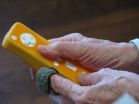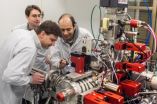(Press-News.org) Massachusetts General Hospital (MGH) investigators have identified specific EEG (electroencephalogram) signatures that indicate when patients lose and regain consciousness under the general anesthetic drug propofol. Their report being published online in PNAS Early Edition is part of a major MGH-based investigation into the mechanisms behind general anesthesia and builds on the results of a November 2012 paper.
"We have discovered highly structured EEG patterns that indicate when people are sedated during administration of propofol, when they are unconscious and when they are able to regain consciousness," says Patrick Purdon, PhD, of the MGH Department of Anesthesia, Critical Care and Pain Medicine, lead author of the PNAS report. "These findings provide precise, neurophysiologically principled markers that can be used to monitor the state of a patient's unconsciousness under propofol general anesthesia."
Although it has been known since the 1930s that certain general anesthestics produce typical pattern changes in EEG – recordings of the brain's electrical activity taken by electrodes placed on the scalp –specific patterns that indicate the loss and recovery of consciousness under anesthesia have never been identified. Monitoring of patients under anesthesia has focused on tracking vital signs such as changes in heart rate and blood pressure. Dosing of anesthetic drugs has been based on target or measured concentrations in the blood or the lungs, even though the primary effects of the drugs are in the brain and central nervous system.
Although the raw EEG and its frequency components can give direct, detailed information about brain states under anesthesia, Purdon explains, most current brain monitoring systems reduced the complex EEG signal to a single number that could not accurately reflect the underlying physiological processes that create the patterns. Indeed clinical studies have found current depth-of-anesthesia monitors to be no more effective at predicting awareness than monitoring drug levels in the lungs.
The November 2012 report from a team led by Purdon, published in PNAS Plus, found a pattern of brain activity that appeared to indicate the loss of consciousness under propofol, but that study was conducted in only three patients and measured brain activity via electrodes previously implanted into participants' brains for the treatment of epilepsy. The current study took highly detailed EEG readings of 10 healthy volunteers during propofol general anesthesia. When used clinically, propofol usually induces unconsciouness within less than a minute, making detailed tracking of EEG changes virtually impossible. But for this study, propofol dosage was slowly increased to a target level over a period of one hour, then slowly decreased over a second hour.
During that time, study participants listened to prerecorded sounds – either words or clicks – presented every four seconds and were asked to identify the type of sound they heard by pressing a button. A loss of response to clicks indicated the onset of sedation, and a persistant loss of response to words was considered loss of consciousness. The readings taken throughout the two-hour study period identified characteric changes in EEG patterns that indicated sedation, loss and return of consciousness, and a state of profound unconsciousness.
An important observation related to interactions between the signaling frequencies measured by EEG. One particular pattern, which the researchers call "trough-max," occurred during transitions in consciousness, particularly right before consciousness returned. Another pattern called "peak-max" was observed at the highest propofol dosage and signified the deepest levels of unconsciousness. Purdon and his colleagues believe that the peak-max signal pattern corresponds with the brain state identified in the November PNAS Plus report, which represented a disruption in communication between different parts of the brain.
"The consequences of this could be huge, because it would mean we have found a brain state where we know patients will be unconscious and could monitor that brain state in the operating room using EEG," Purdon says. "Appearance of the trough-max pattern would provide a way to predict when patients might be regaining consciousness. With these fundamental neurophysiological markers of the sedative and unconscious states under propofol and with some existing EEG equipment, we can start monitoring these EEG signatures when administering propofol immediately."
An instructor in Anesthesia at Harvard Medical School, Purdon adds, "We are working on new monitoring technologies to develop of EEG monitors that will display the peak-max and trough-max patterns, helping us ensure when patients are unconscious and predict when they might be regaining consciousness. We also are working to characterize similar EEG patterns for other anesthetic agents and to develop a program to train anesthesiologists how to interpret the EEG in terms of the neurophysiology and mechanisms for different drugs." A patent for anesthesia monitoring based on these findings is pending.
Emery N. Brown, MD, PhD, MGH anesthetist, the Warren M. Zapol Professor of Anaesthesia at Harvard Medical School and the study's senior author adds, "This work helps establish the basic and clinical science needed to set standards for use of the EEG to track the brain states of patients under general anesthesia. Reading the EEG will allow anesthesia caregivers to adjust dosage more precisely and thereby help reduce the incidence of cognitive dysfunction and delirium following anesthesia as well as making unintended regaining of awareness while under anesthesia a phenomenon of the past." Brown is also a professor in the MIT Department of Brain and Cognitive Sciences and the Institute of Medical Engineering and Science.
###
The study was supported by National Institutes of Health Director's Pioneer Award (DP1-OD003646) to Brown, NIH New Innovator Award DP2-OD006454 to Purdon, and additional NIH grants R01-MH071847, K25-NS057580 and R01-EB006385.
Massachusetts General Hospital, founded in 1811, is the original and largest teaching hospital of Harvard Medical School. The MGH conducts the largest hospital-based research program in the United States, with an annual research budget of more than $775 million and major research centers in AIDS, cardiovascular research, cancer, computational and integrative biology, cutaneous biology, human genetics, medical imaging, neurodegenerative disorders, regenerative medicine, reproductive biology, systems biology, transplantation biology and photomedicine. In July 2012, MGH moved into the number one spot on the 2012-13 U.S. News & World Report list of "America's Best Hospitals."
EEG patterns indicate when patients lose, regain consciousness under propofol anesthesia
Mass. General study suggests more accurate way to monitor patient awareness during general anesthesia
2013-03-05
ELSE PRESS RELEASES FROM THIS DATE:
Seniors who play video games report better sense of emotional well-being
2013-03-05
New research from North Carolina State University finds that older adults who play video games report higher levels of emotional well-being.
Researchers asked 140 people aged 63 and older how often they played video games, if at all. The study participants then took a battery of tests to assess their emotional and social well-being. 61 percent of study participants played video games at least occasionally, with 35 percent of participants saying they played at least once per week.
The study found that participants who played video games, including those who only played ...
Before and after: Ad placement should reflect cultural conceptions of time
2013-03-05
Consumers respond more favorably to advertising when the placement of product images is consistent with the way they visualize time, according to a new study in the Journal of Consumer Research.
"Whether a product's image is placed on the left or the right of an advertisement matters for products promising results occurring over time (weight loss aids or anti-aging creams) or products that are valued because they are old or new (antique furniture, modern art, wine, new technologies)," write authors Boyoun (Grace) Chae and JoAndrea Hoegg (both University of British Columbia).
Consumers ...
U of M researchers utilize genetically corrected stem cells to spark muscle regeneration
2013-03-05
MINNEAPOLIS/ST. PAUL (March 5, 2013) – Researchers at the University of Minnesota's Lillehei Heart Institute have combined genetic repair with cellular reprogramming to generate stem cells capable of muscle regeneration in a mouse model for Duchenne Muscular Dystrophy (DMD).
The research, which provides proof-of-principle for the feasibility of combining induced pluripotent stem cell technology and genetic correction to treat muscular dystrophy, could present a major step forward in autologous cell-based therapies for DMD and similar conditions and should pave the way ...
The Joint Facial and Invasive Neck Trauma (J-FAINT) Project, Iraq and Afghanistan 2003-2011
2013-03-05
Alexandria, VA — With over 37,000 face and neck injuries in more than 7,000 military personnel during Operations Iraqi Freedom (OIF) and Enduring Freedom (OEF), a new study in Otolaryngology–Head and Neck Surgery concludes additional training in the management of these injuries and improvements in body armor could be beneficial.
The authors note that OIF and OEF have changed the way military surgeons approach facial and penetrating neck trauma. "This study highlights the need for a trained head and neck surgeon in the deployed environment to address these changes and ...
Comparison investing: Why are consumers more willing to take risks when they can compare products?
2013-03-05
Consumers are more willing to take risks and accept delays in exchange for greater benefits when they are able to compare products, according to a new study in the Journal of Consumer Research.
"Rationally speaking, consumer preferences should be the same whether their product choices are presented side-by-side and evaluated comparatively or presented one at a time and evaluated in isolation, but it makes a remarkable difference in consumer decision-making," write authors Christopher K. Hsee (University of Chicago Booth School of Business), Jiao Zhang (University of Miami), ...
Targeting diet products: Why are more independent consumers better at delaying gratification?
2013-03-05
Product benefits that occur later in time are more likely to appeal to more independent consumers than to those who are more group or family oriented, according to a new study in the Journal of Consumer Research.
"More independent consumers think of the future in abstract terms and perceive future events as happening in the more distant future, whereas consumers who are less independent think of the future in concrete terms and perceive future events as happening sooner," write authors Gerri Spassova (Monash University) and Angela Y. Lee (Kellogg School of Management, ...
Texas A&M research contributes to improved ultrasound imaging
2013-03-05
Ultrasound technology could soon experience a significant upgrade that would enable it to produce high-quality, high-resolution images, thanks to the development of a new key material by a team of researchers that includes a professor in the Department of Biomedical Engineering at Texas A&M University.
The material, which converts ultrasound waves into optical signals that can be used to produce an image, is the result of a collaborative effort by Texas A&M Professor Vladislav Yakovlev and researchers from King's College London, The Queen's University of Belfast and ...
On the trail of mucus-eaters in the gut
2013-03-05
This press release is available in German.
The microbiology team of David Berry, Alexander Loy and Michael Wagner from the Faculty of Life Sciences, in collaboration with scientists at the Max F. Perutz Laboratories (University of Vienna and the Medical University of Vienna) and with the help of NanoSIMS technology, has for the first time succeeded in directly observing microorganisms feeding on the intestinal mucosa. The results of this research project appear in the current issue of the prestigious journal "Proceedings of the National Academy of Sciences" (PNAS).
To ...
Homes in neighborhoods with protected open space bringing higher sale prices
2013-03-05
Homes in neighborhoods that incorporate protected open space command prices 20 to 29 percent higher than those without open space, according to a new study by a Colorado State University multidisciplinary research team that included Wildlife Conservation Society scientist, Sarah Reed.
Conservation development is an approach to the design, construction, and stewardship of a development that protects natural resources while also providing social and economic benefits to people. The properties in this study specifically incorporated protected open space into the design of ...
A window into Europa's ocean lies right at the surface
2013-03-05
PASADENA, Calif.—If you could lick the surface of Jupiter's icy moon Europa, you would actually be sampling a bit of the ocean beneath. So says Mike Brown, an astronomer at the California Institute of Technology (Caltech). Brown—known as the Pluto killer for discovering a Kuiper-belt object that led to the demotion of Pluto from planetary status—and Kevin Hand from the Jet Propulsion Laboratory (JPL) have found the strongest evidence yet that salty water from the vast liquid ocean beneath Europa's frozen exterior actually makes its way to the surface.
The finding, based ...
LAST 30 PRESS RELEASES:
Jeonbuk National University study shows positive parenting can protect adolescents against self-harm
Surface-engineered ZnO nanocrystals to tackle perfluoroalkyl substance contamination
This new understanding of T cell receptors may improve cancer immunotherapies
A new fossil face sheds light on early migrations of ancient human ancestor
A new immunotherapy approach could work for many types of cancer
A new way to diagnose deadly lung infections and save lives
40 percent of MRI signals do not correspond to actual brain activity
How brain-inspired algorithms could drive down AI energy costs
Gum disease may be linked to plaque buildup in arteries, higher risk of major CVD events
Contrails are a major driver of aviation’s climate impact
Structure of dopamine-releasing neurons relates to the type of circuits they form for smell-processing
Reducing social isolation protects the brain in later life
Keeping the heart healthy increases longevity even after cancer
Young adults commonly mix cannabis with nicotine and tobacco
Comprehensive review illuminates tau protein's dual nature in brain health, disease, and emerging psychiatric connections
Book prepares K-12 leaders for the next public health crisis
Storms in the Southern Ocean mitigates global warming
Seals on the move: Research reveals key data for offshore development and international ecology
Sports injuries sustained during your period might be more severe
World's first successful 2 Tbit/s free-space optical communication using small optical terminals mountable on satellites and HAPS
Can intimate relationships affect your heart? New study says ‘yes’
Scalable and healable gradient textiles for multi‑scenario radiative cooling via bicomponent blow spinning
Research shows informed traders never let a good climate crisis go to waste
Intelligent XGBoost framework enhances asphalt pavement skid resistance assessment
Dual-function biomaterials for postoperative osteosarcoma: Tumor suppression and bone regeneration
New framework reveals where transport emissions concentrate in Singapore
NTP-enhanced lattice oxygen activation in Ce-Co catalysts for low-temperature soot combustion
Synergistic interface engineering in Cu-Zn-Ce catalysts for efficient CO2 hydrogenation to methanol
COVID-19 leaves a lasting mark on the human brain
Scientists use ultrasound to soften and treat cancer tumors without damaging healthy tissue
[Press-News.org] EEG patterns indicate when patients lose, regain consciousness under propofol anesthesiaMass. General study suggests more accurate way to monitor patient awareness during general anesthesia



